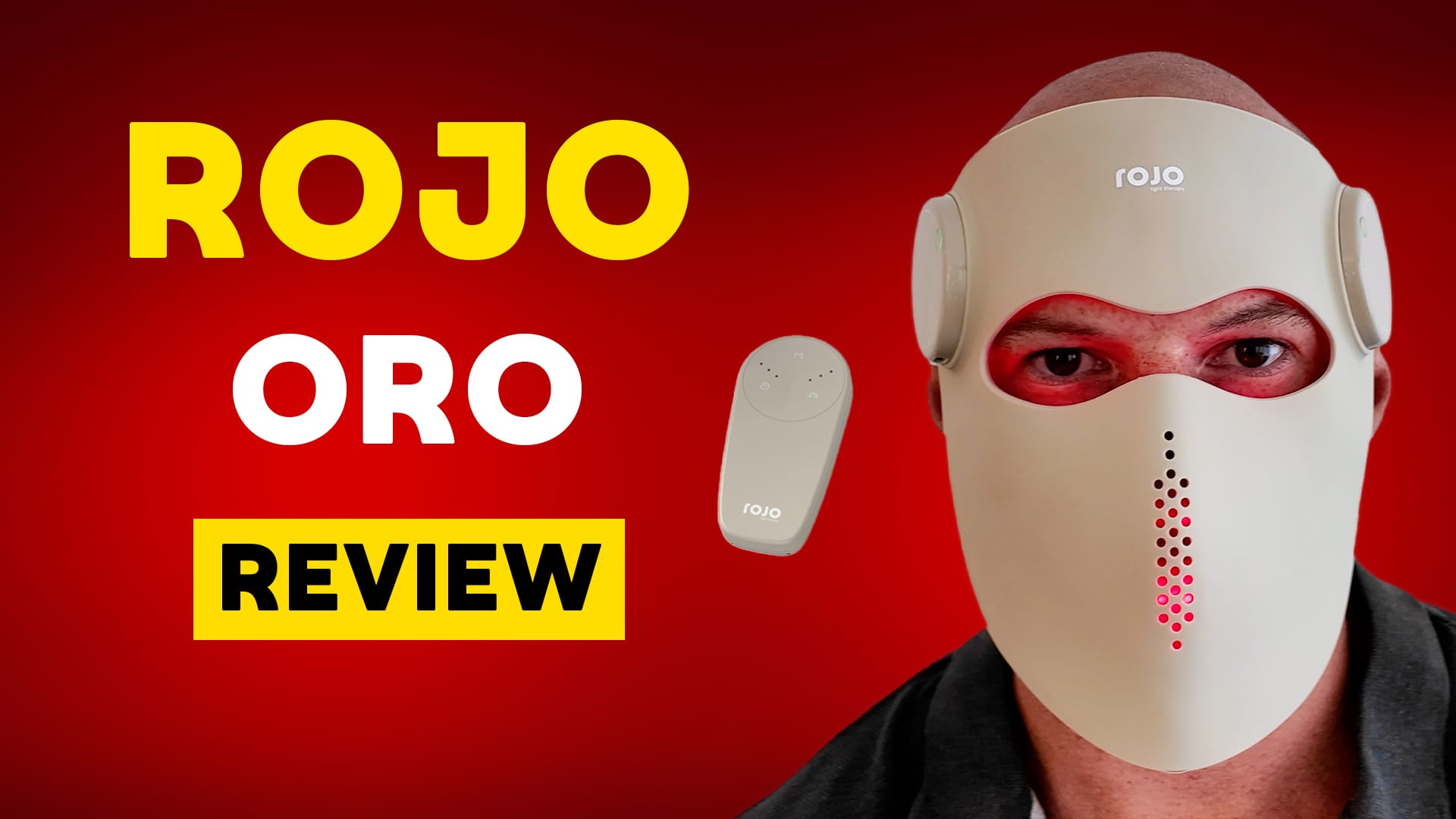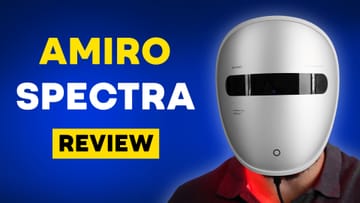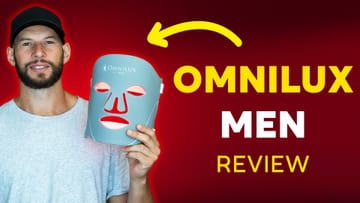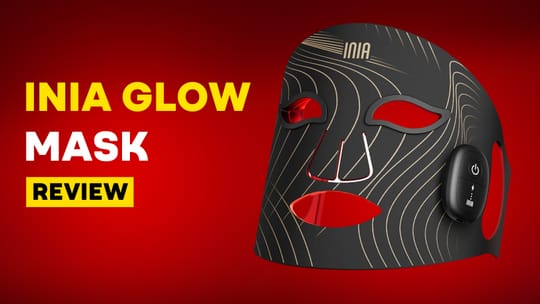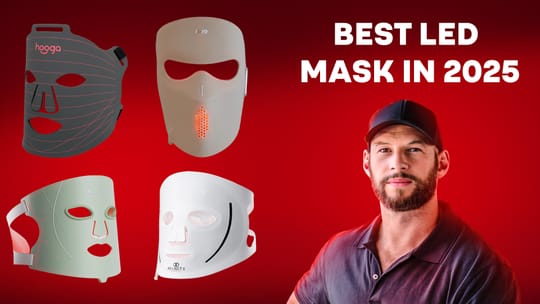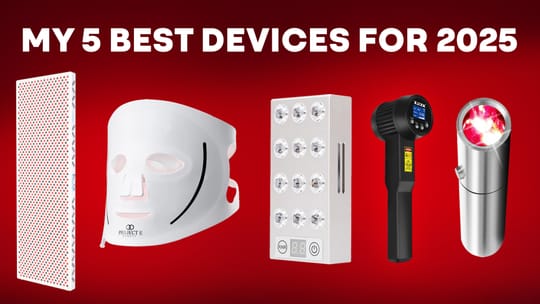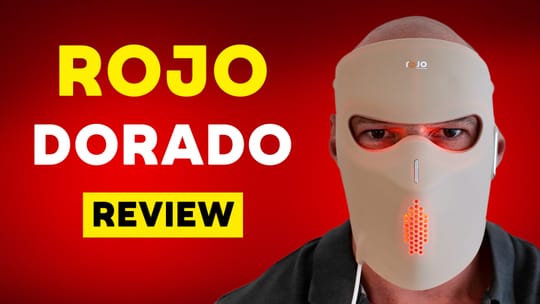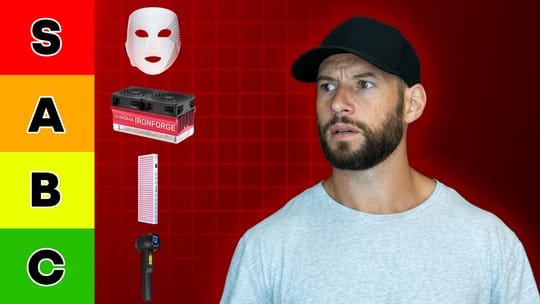The Rojo Oro light therapy mask is unlike most other red light masks on the market — it uses lasers instead of LEDs. That’s right, actual laser diodes built into the mask. It’s a bold design choice that sounds impressive, but does it actually work better? And is it worth paying extra for?
I put the Rojo Oro through my standard 100-point testing system to determine the results. I’ll break down exactly how it performed in every category — from comfort and ease of use, to therapeutic power, coverage, and price — and of course, I’ll share the final score at the end.
Round 1: Comfort & Ease of Use
Fit and Comfort
The Rojo Oro is what I’d call a semi-soft mask — it’s not completely flexible like those silicone models that wrap around your face, but it’s not a rigid hard shell either. It has a bit of molding to it, which actually helps the fit.
Once on, it hugs the face nicely and stays secure without pressing too hard. I had no issues with lip restriction, and I could breathe and talk easily while wearing it. Unlike some other masks, it didn’t make me sweat much, which was a pleasant surprise.
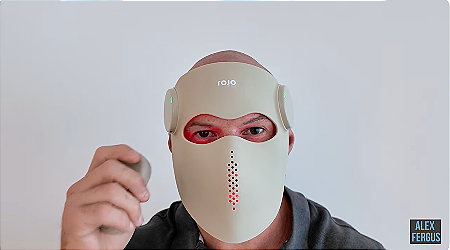
That’s especially worth noting because Rojo’s LED-only mask caused significant sweat buildup for me. The big difference? That one has an eye insert, which traps heat and moisture. The Rojo Oro doesn’t, which helps a lot.
That said, it’s not perfect. After about 5–10 minutes, moisture starts to collect around the mouth area. There are small ventilation holes there, but they’re not quite enough. Another slight downside — there’s no strap adjustment. It fits my face well, but if yours is larger or smaller, you might not get complete contact around the nose and cheeks.
Comfort Score: 12.5 / 15
Operation & Controls
The operating system is where things start to get… interesting.
The batteries are built directly into the mask, which is a great feature. It charges via USB-C, which is also a great feature. However, to turn it on, you must use both the mask and a wireless controller.
Here’s how it works:
You first power on the mask itself. Then you turn on the controller, hold down a button — and only then does the mask come to life. From there, the controller allows you to adjust the brightness, timer, and light mode (blue for acne and eczema, or red and near-infrared for anti-aging).
While I appreciate the cordless design, I don’t love this two-device setup. It’s just unnecessarily complicated. Children can easily play with or misplace the controller, and when the batteries eventually wear out, they’ll need to be replaced separately.
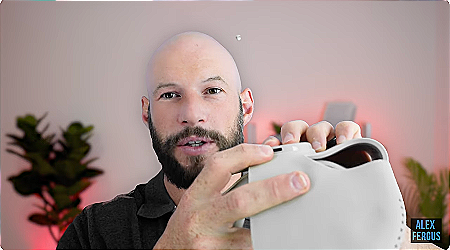
Personally, I’d rather have all the controls built directly into the mask. There’s already one button there — why not add a few more and call it a day?
The manual explains the functions adequately; however, some reliance on it is necessary to understand the controls fully. Additionally, every mode includes near-infrared light, which cannot be deactivated, limiting options for users who may prefer red or blue only.
The good news? It’s light, portable, and folds up easily — great for travel.
Operation Score: 4 / 10
➡️ Round 1 Total: 16.5 / 25
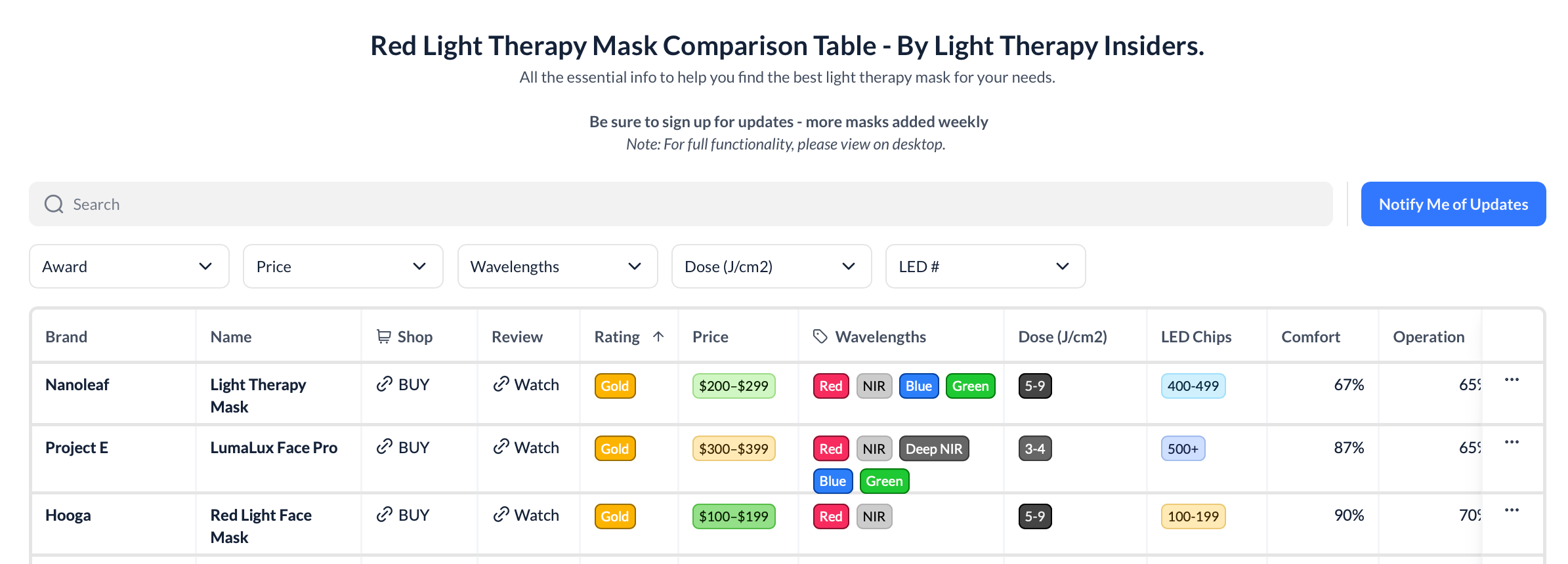
☝️ Use my Mask Comparison Table ☝
Access all my data on each mask
Compare different masks side by side
Search by price, wavelengths, and more
Links to my reviews and discount codes
Round 2: Therapeutic Power
Wavelengths
Testing with my spectrometer showed four distinct wavelengths:
- Red light: 665nm — the gold standard for collagen production and overall skin health.
- Near-infrared: 850nm — penetrates deeper, promoting circulation and nutrient delivery.
- Deep near-infrared: 1064nm — penetrates even deeper, though research on skin benefits here is limited.
- Blue light: 460nm — included for acne and skin clarity (this one uses LEDs, not lasers).
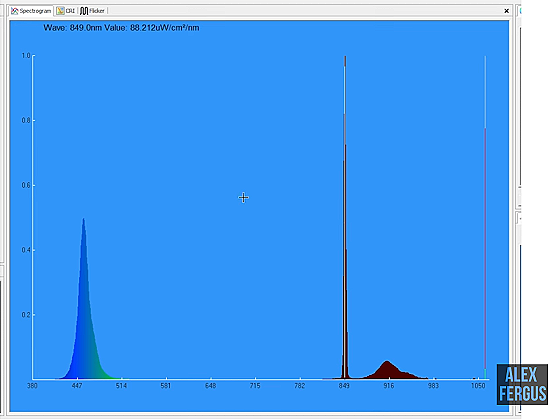
Technically, the mask uses lasers for red and near-infrared light, and LEDs for blue light. The wavelengths are precise — those vertical peaks you see on the spectrometer are unique to lasers.
Three out of four wavelengths are excellent choices, while the fourth (1064 nm) is more of a bonus.
Wavelength Score: 8 / 10
Power Output (Fluence)
This is where things get tricky. Measuring power from lasers is difficult because the light doesn’t spread like LEDs do — it’s highly concentrated in tight beams.
When I measured directly over the laser chips, I saw readings ranging from 4 mW/cm² up to 21 mW/cm², depending on the exact distance. That’s a vast range, and it’s precisely why I’m not a fan of lasers in facial masks.
Lasers produce intense, narrow points of light. So unless those lasers are positioned precisely where you want to treat, you’ll get patchy results. LEDs, on the other hand, spread light evenly over a larger area, making them much more forgiving.
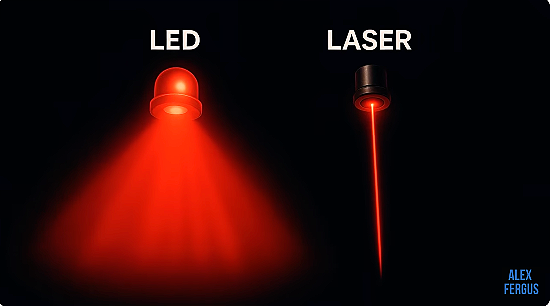
After multiple tests, the average dose was 3.7 J/cm² (default 5-minute session, lowest power). That’s just slightly below the optimal dose range, but still close. You could easily hit the sweet spot by upping the power or time.
However, that figure represents energy right above the lasers — move just a bit away, and it drops off sharply.
Fluence Score: 12 / 15
➡️ Round 2 Total: 20 / 25
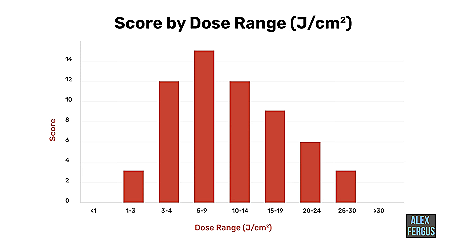
Round 3: Coverage
Laser Count
Let’s talk coverage, because this is where the Rojo Oro Laser Mask’s strengths and weaknesses really come into focus.
The mask contains 72 LED/laser bulbs, some of which have multiple chips emitting red, near-infrared, and blue light simultaneously, totaling 236 light-emitting chips. While this seems impressive, how evenly the energy reaches the skin is crucial, and this is where lasers can be problematic.
Lasers produce highly concentrated beams, unlike LEDs, which naturally disperse light over a wider area. On my skin, this resulted in intense peaks of energy in some areas and gaps in others, leaving certain zones under-treated. Some companies claim that lasers provide deeper penetration and pinpoint accuracy, which is technically correct; however, effectiveness requires precise placement over target areas. To cover the whole face evenly, many more lasers would be necessary.
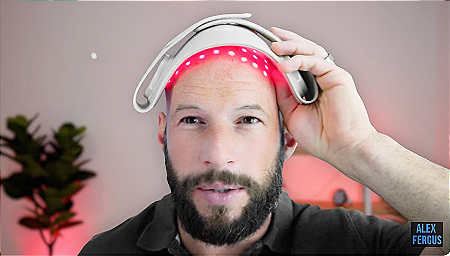
When I compared it visually to Rojo’s LED mask, the difference was dramatic. The LED version produced smooth, even light distribution, while the laser version showed clear hot spots and gaps.
This uneven coverage means that some areas receive too much light, while others receive very little.
Laser Count Score: 6 / 10
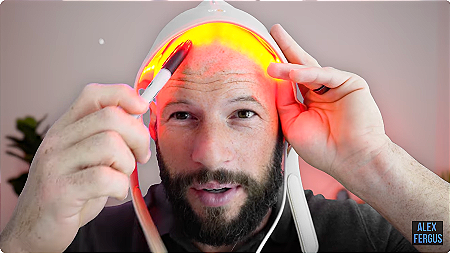
Zone Coverage
Coverage is where the mask falls short. The forehead and temples get plenty of light, but the eye region, under-eyes, and nose bridge are left in the dark — literally. The large eye cutouts mean you’re not getting any light there at all.
There is some light hitting the lips, chin, and jawline, but it’s uneven overall.
Coverage Score: 6.5 / 15
➡️ Round 3 Total: 12.5 / 25
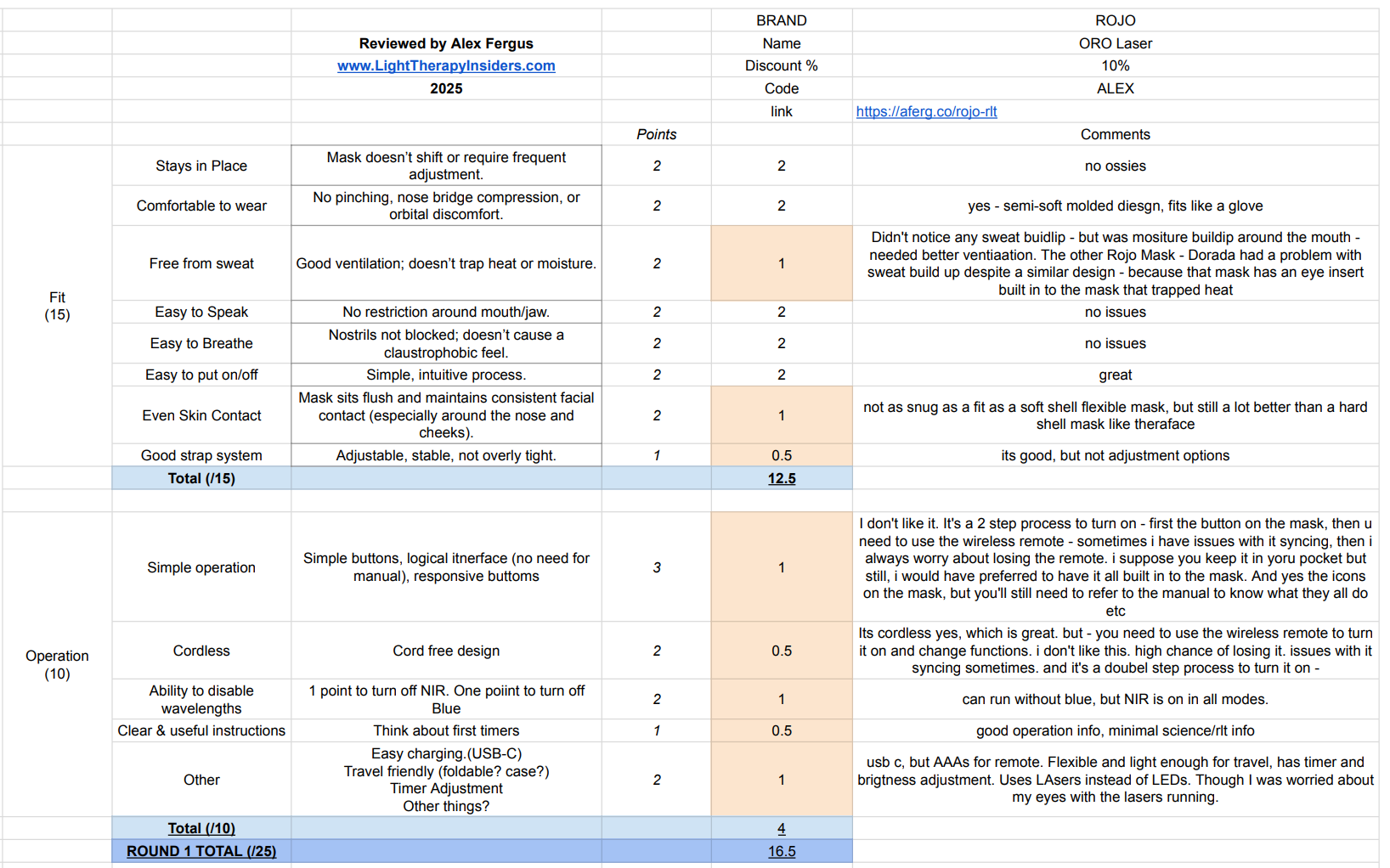
👆 View my score cards- all my notes and data, or do a comparison between masks, check out my Mask Comparison Table. 👆Easy to use, links to reviews, all my notes (scorecard) on every mask I have reviewed, and more!
Round 4: Price & Peace of Mind
Price
The Rojo Oro Laser Mask retails for $460, but with my link, https://aferg.co/rojo-rlt, and discount code ALEX, you'll receive a 10% discount and free shipping, making it available for $414. Given the unique design and laser tech, that’s not outrageous — but not exactly a bargain either.
Price Score: 12 / 20
Peace of Mind
You do get a solid 2-year warranty and 45-day return period, which is reassuring. Rojo is also a well-established company with a good track record in red light therapy devices, so you’re buying from a trusted brand.
Peace of Mind Score: 3.5 / 5
➡️ Round 4 Total: 15.5 / 25
Final Score: 64.5 / 100
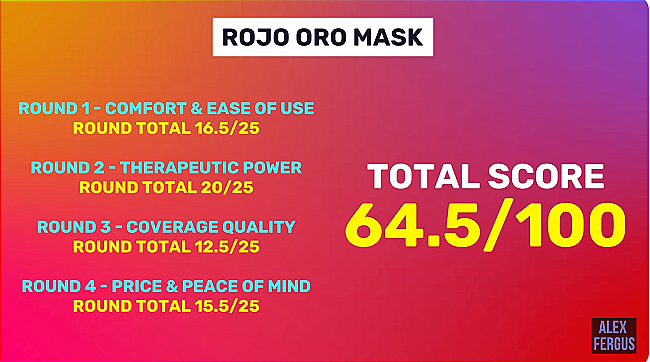
The Rojo Oro Laser Mask earns a 64.5 out of 100, and honestly, that feels about right.
There’s a lot to like here: the mask delivers solid energy output, includes all the right wavelengths for skin rejuvenation and anti-aging, and the fit is excellent. However, it is held back by a few factors — primarily the overly complicated control system and the laser-based design.
The precision and deep penetration of lasers sound great on paper, but in practice, the spotty coverage means you’re not getting consistent results across your whole face.
If Rojo had just used LEDs instead of lasers, this mask would probably score much higher — and cost less, too.
Will You See Benefits?
Yes, you’ll still likely see improvements in skin tone and texture, especially in the areas that receive direct laser contact. The wavelengths are excellent, and the energy levels are within the effective therapeutic range. However, you may notice uneven results due to the patchy coverage.
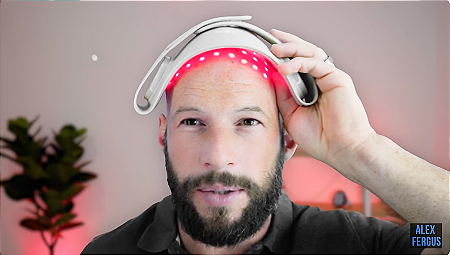
Pros & Cons
Pros:
- Great fit; comfortable and breathable
- Solid wavelength selection (665, 850, 1064, 460 nm)
- USB-C rechargeable and portable
- Legit company with warranty and returns
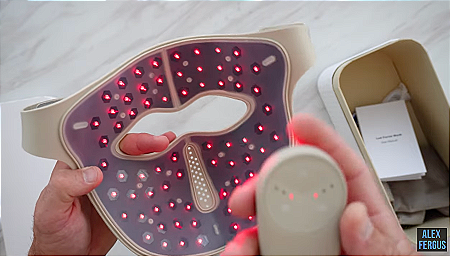
Cons:
- Complicated wireless control system
- Uneven coverage — especially around the eyes
- Limited adjustability
- Expensive for what it offers
- Laser concentration can cause patchy treatment
Check out this epic Shopping Tool, years in the making! You can filter products by price, number of LEDs, total power, irradiance, height, width, warranty, company, the company's location, warehouse, year released, pulsing, flicker, modular support, EMF, built-in timer, multi-chip LEDs, stands included, specific wavelengths, shipping, value, noise level, and more!
Alternative Options
I think there are better options available at this price point. Here’s a closer look at what you could consider:
- Rojo Dorada – This is Rojo’s other mask, available for $325. While it’s still far from perfect, particularly in terms of LED coverage, it follows a similar design to the Rojo Oro. It actually packs in a lot more LEDs, meaning coverage is better than the Rojo Oro Laser Mask.
- Megelin Laser & LED Mask– If you really want lasers, Megelin has a mask that uses both lasers and LEDs. The main drawback is the price: it’s $850. Even though it has a few more LEDs and laser chips than the Rojo Oro, the overall coverage quality is still far from ideal.
- Project E Beauty LumaLux Pro LED Face Mask – This is a solid alternative for those seeking strong coverage without incurring a high cost. You can pick it up in the low $300 range, and it includes 800 LED chips, making it one of the better-performing masks for even light distribution.
- Megelin Laser & LED Mask
- LumaLux Pro LED Mask: Project E’s LED Mask Reviewed
- My Rojo Dorada Review — coming soon!
Final Thoughts
In the end, the Rojo Oro feels like a mask that’s trying too hard to impress — with lasers, wireless controls, deep infrared, and a fancy design — but it forgets the basics of what makes a red light mask effective: coverage, simplicity, and balance.
Will it work? Yes. Is it worth $414? Maybe — if you’re set on trying laser-based tech. But for most people, you’ll get better coverage and results from a good LED mask in the same or lower price range.
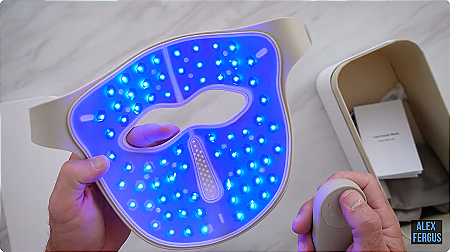
If you like the Rojo brand but want better value, consider the Rojo Dorada (review coming soon), which features a similar design, improved coverage, and a lower price tag of $325.
Alternatively, if you're looking for a high-performing mask under $350, the Project E L’Lume Lux Pro is a fantastic option, featuring over 800 LED chips and even light distribution.
As for me? I’d skip the lasers.
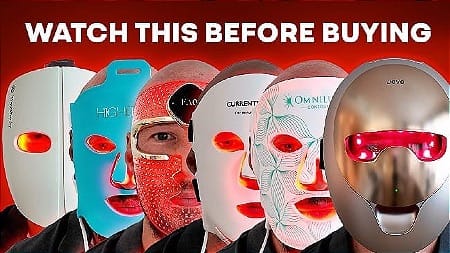
Here are the products I mentioned in my Rojo Oro Red Light Therapy Mask review:
🔥 Rojo Refine Oro or The Rojo Dorada, then use code ALEX and click here: https://aferg.co/rojo-rlt
🔥 Project E Beauty LED Face Masks, Use code ALEX15 for 15% off: https://aferg.co/projectebeauty
🔥 Megelin Laser & LED Mask, use code ALEX for 5% off: https://aferg.co/megelin
My Latest Reviews
♦️ How to Find YOUR Best Red Light Therapy Mask
♦️ Spectra 5-in-1 Mask Review — Worth $199?
♦️ Bought This $37 Amazon Red Light Mask — Big Mistake.
♦️ vs LEDs: Exposed — What Really Works for Your Skin
Found This Interesting? Look At These Articles:
♦️ Light Therapy EXPLAINED: Basic Terms Guide!!!
♦️ Red Light Therapy Help Scars? The Science
♦️ You Need To Know About Tinnitus & Red Light Therapy
♦️ Light Therapy For Migraines 101: Why The Research Is Super Promising!
Alex's Bio
Alex Fergus wrote this blog post. Alex is an ISSN Sports Nutrition Specialist, Fitness Professional, and certified Superhuman Coach who continues to expand his knowledge base and help people worldwide with their health and wellness. Alex is recognized as the National Record Holder in Powerlifting and Indoor Rowing and has earned the title of the Australian National Natural Bodybuilding Champion. Having worked as a health coach and personal trainer for over a decade, Alex now researches all things health and wellness and shares his findings on this blog.

